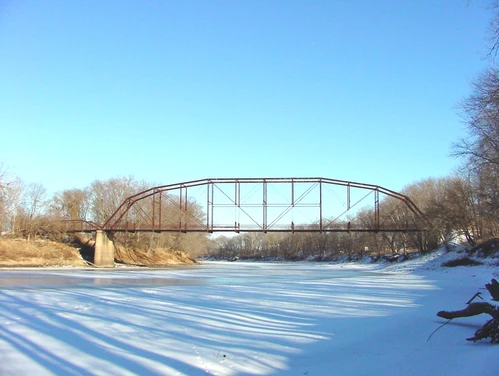- Year constructed: 1904
- Alternate name: Acheson, Topeka, and Santa Fe Railroad Bridge
- Bridge type: Pin-Connected Pennsylvania Through Truss
- National Register of Historic Places status: Listed
- Length: 293 feet
- Width: 15 feet
- Spans: 1
- FHWA: 219350
- Jurisdiction: Lee County
- Location: Old Quarry Road over Skunk River, 3.5 miles northwest of Denmark, Section 7, T69N-R4W (Denmark Township)
Details
Located in northern Lee County near Denmark, this long-span through truss crosses the Skunk River. The structure features a 240-foot, pin-connected Pennsylvania truss with a small pony truss at one end, all supported by a stone/concrete substructure. Known as the Bridgeport Bridge, this structure dates to 1903, but it was predated by an earlier bridge at this crossing, which experienced structural problems in 1887 and 1893. On 15 September 1889 the county boards from Des Moines and Lee met to discuss the bridges fate. Evidently, the truss itself was in repairable condition, but the middle stone pier was giving way and would either need to be rebuilt, or the bridge would need to be replaced altogether. The decision was made in the fall of 1903 to rebuild the entire structure and to direct a Lee County engineer to prepare a cost estimate and specifications. Two months later bids were opened and the Clinton Bridge and Iron Works had the lowest price for the best bridge. Built on a joint account with the two counties, the bridge was presumably completed by the Iowa bridge builder, using steel components rolled by the Pittsburgh-based Carnegie Steel Company, by the contractual deadline, July 1904. Costing $5,110, the stately 240-foot span was formally accepted by the boards in November the same year. Except for maintenance-related repairs, the Bridgeport Bridge carried local traffic in its rural setting while maintaining a high degree of both structural and historical integrity, until its recent closure.
Serving as a major inter-county crossing of the Skunk River for almost 90 years, the Bridgeport Bridge is historically significant for its longstanding role in the development of regional transportation. The structure's channel span is technologically noteworthy as a well-preserved example of a Pratt truss subtype, the Pennsylvania truss. With its polygonal upper chords and subdivided panels, the truss exemplifies this relatively uncommon structural type, which was used primarily for long-span applications after the turn of the century. And with its 240-foot span length, the Bridgeport Bridge is distinguished as the longest pinned truss remaining in Iowa. It is one of the state's more significant early roadway trusses.
Adapted from Crow-Dolby and Fraser 1992
Areas Served
- Lee
